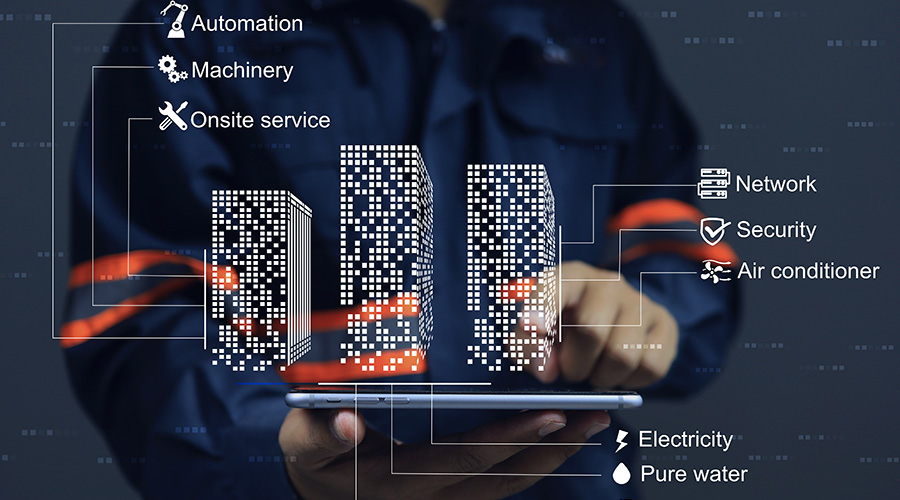Net Working
Moving beyond e-commerce to make the most of the Internet
Ten years ago, maintenance and engineering departments didn’t have electronic addresses or home pages. The Internet was not yet a business term. And although institutional and commercial facilities had electrical lines and phone lines, they were not “wired” in today’s sense.
Much has changed in a decade. Despite what business analysts call the burst of the dot-com bubble, the information revolution continues. And it is creating a paradigm shift in almost every aspect of facilities, from interpersonal communication to purchasing habits.
Even maintenance departments, where much of the work is still hands-on, cannot escape the benefits of using online tools. In many facilities, paper work orders are dwindling and being replaced by e-mail communication or orders received via an intranet page. Traditional purchasing channels are sidelined in favor of electronic means, and even communication with workers in the field is being altered at a radical rate. In short, despite the hesitant approach in many facilities to online purchasing, the Internet is reshaping — and improving — nearly every aspect of maintenance and engineering.
Purchasing
Online purchasing of maintenance, repair and operations (MRO) parts and equipment was supposed to be the leading edge of the Internet in facilities, but organizations held back until promised savings could materialize. Many are still waiting.
Managers and their organizations for many years have used written purchase orders and phone calls to order parts and equipment from regular vendors. Replacing this time-tested purchasing process with a Web site involves a major transition — revamping the department’s system of doing things, which can include changing software and hardware, as well as ordering, purchasing and inventory management.
Russell Bond, facility supervisor at Mayo Clinic Hospital in Phoenix, says he occasionally buys online, but nearly all managers say they still use “bricks and mortar” vendors more than “click and order” vendors.
What has changed about the MRO purchasing process is the type of communication used, both with vendors and with the facility’s purchasing departments.
On-line purchasing habits at St. Joseph’s Health Center in Kansas City, Mo., seem to mirror those of many other institutions, says John Colard, the center’s director of plant services. The facility’s maintenance department buys some items online, Colard says, but most often department staff use the Internet to find information.
“One of our biggest uses for the Internet is to locate vendors,” Colard says. “All we need is a name to go online and gather contact information for vendors, which is very helpful to us.”
Intranets also play a larger role in the MRO purchasing process for many maintenance and engineering departments.
“We used to call in our purchase requests,” Bond says. “But most of the time now, we fill out purchase requests using the clinic’s Intranet and send it to our materials management department.”
Work Orders
Electronic communication is quickly replacing the paper trail of traditional work orders in many facilities. While some organizations still use hard-copy orders, many other facilities have turned to Internet-based communication. Some institutions accept e-mailed work orders, but many now use an intranet Web site.
Colard says his hospital’s information services department is establishing an intranet, through which his department will be able receive work requests from anyone in the hospital.
Called C-net, St. Joseph’s intranet will enable the department to print out work orders as they arrive.
“Every work order done in C-Net comes to our department and needs approval,” Colard says. “We aren’t quite there yet, but sometime in the near future, we expect that people who request work orders can go onto C-Net to get updates. They can see whether or not the work order was approved, and when the work is scheduled to be done.”
Colard also says that the C-net will integrate with the hospital’s computerized maintenance management system (CMMS). C-Net also will automatically update the CMMS data fields — a big performance and efficiency boost for the maintenance staff.
A Software Evolution
A new breed of software, the application service provider (ASP) model, is relatively new, but might have the largest impact of any Internet-related development so far.
Traditional CMMS require in-house servers to host the software and the supporting database, not to mention computer-savvy computer technicians who can update or troubleshoot the software.
With the ASP model, facilities can purchase the right to access the application via a Web browser from the CMMS provider, while leasing server space. An ASP-style CMMS is ideal for smaller facilities that do not have storage space on their server, for organizations without the computer staff to maintain such a program.
Most CMMS, whether ASP or not, operate via the Web. Facilities that host their own database and software on internal servers use an intranet site to transfer data between the software user and database.
Bond says he uses a CMMS system to handle all general maintenance at the clinic, from work order requests to routinely scheduled maintenance. The system lets the department track a host of information, including work-order completion rates and the date work was finished. Bond says the clinic’s maintenance department processes about 450 work requests per month and more than 250 preventive maintenance (PM) tasks per month.
In fact, one of the biggest uses for CMMS programs is as a reminder program for PM tasks. Maintenance personnel at the Massachusetts Institute of Technology (MIT) use a CMMS to track work in 140 buildings on its Cambridge campus.
“We schedule times for routine maintenance using the system,” says Steve Miscowski, MIT’s manager of operations, administration and planning. “We know when it’s time to work on the safety showers, and conduct routine generator testing. It also helps us out with our filter program.”
As ASP and other Internet based technologies evolves, managers are certain to tap into the benefits they provide. Among the challenges in this effort, however, is determining which technology truly benefits the maintenance and engineering mission and which are little more than detours on the information superhighway.
Communicating When it Counts
When a gas line starts to leak or a chiller fails in 100-degree temperatures, speedy communication is vital to successful maintenance operations. While it’s true that the Internet and e-mail programs have improved the delivery and volume of information, they remain secondary communication channels for many maintenance and engineering departments.
In fact, e-mail and Internet access isn’t even universally available. Not all workers in St. Joseph Health Center’s maintenance department has Internet or e-mail access, says John Colard, center’s director of plant services. The department tried using e-mail but found the system cumbersome and occasionally unreliable. As a result, everybody, including Colard, carries a radio, and some also have cell phones.
A similar system is in place at the Mayo Clinic Hospital in Phoenix. Russell Bond, facility supervisor, says that all 20 of his staff have access to the Internet and most spend at least an hour a day getting maintenance updates or work orders from the system. But radios and pagers remain the preferred choice for communication when they’re out in the field.
“We use text messaging,” Bond says. “We can send them work orders on their digital pagers that lets them know what work needs to be done and in what room number.”
But for as convenient as e-communication can be, many managers agree that it is important to have contact with other staff members or tenants.
“Customer contact is incredibly important,” Bond says. “That’s why I have my guys doing floor rounds and making sure everything’s okay.”
During these rounds, Bond’s staff frequently conducts on-the-spot maintenance at the request of clinic workers. "Even though they usually can fix it right away, my workers still have the person making the request submit a work order so that we can update our system."
|
Related Topics:











